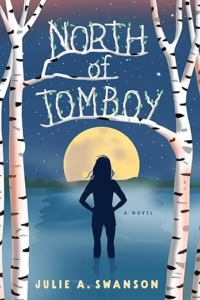North of Tomboy
Julie A. Swanson
SparkPress
Published September 2, 2025
Amazon | Bookshop | Goodreads
About North of Tomboy
For fans of Kacen Callender, Lin Thompson, and Kyle Lukoff, comes a middle grade novel set in 1973 about a child who feels more boy than girl and is frustrated that people act blind to that when—aside for her stupid hair and clothes—it should be obvious!
Shy fourth grader Jess Jezowski turns the tables on her mom when she’s given yet another girly baby doll for Christmas. This time, instead of ignoring or destroying it, she transforms it into the boy she’s always wanted to be—a brave, funny little guy named Mickey. Making him talk, Jess finally lets the boy in her express himself.
But when Mickey evolves to become something more like an alter ego whose voice drowns out her own and the secret of him escapes the safety of her family, Jess realizes Mickey’s too limited and doesn’t allow the boy part of her a big enough presence in the world. She must find a way to blend him into her—so she can be that side of herself anywhere, around anyone.
Jess tries to wean herself from the crutch of Mickey’s loud, comical persona, and to get her family to forget about him, but she struggles to do both. What will it take for her to stop hiding behind Mickey and get people to see her for who she truly is? Based on the author’s experience growing up on Michigan’s rural Leelanau Peninsula in the ’70s, North of Tomboy includes artwork throughout.
My Review
I read a review of North of Tomboy a few weeks ago on Always in the Middle. I think he made a lot of good points about the book. He noted the length being a little bit long for the type of story this is, and I’d agree. It’s the kind of book that makes you laugh, but makes you think right along with the main character. Some elements of the book feel more like a coming of age story than a middle grade novel, but the voice is solidly middle grade. Jess really feels like a nine-year-old kid. Lots of times her ideas about what’s happening are imperfect, or she accidentally stumbles onto a solution that works. For example, she realizes the family listens to Mickey differently than they listen to her. That kind of thinking reminded me a lot of myself as a kid.
I also appreciated how nuanced the family members are. Jess is one of four kids in a closeknit family. She’s closest to her youngest sister, Lucy, but often wants to do the things her older brothers are doing. Her mom navigates difficult situations with Jess’s dad in a way that Jess struggles to understand. She also constructs a lot of rules about Jess’s appearance, requiring her to dress and act “like a girl.” Though those things are hurtful and make Jess feel unheard and unseen, Jess appreciates her mom’s emotional honesty about family matters.
The 1970s setting is interesting, too. Politics and historical events don’t intrude into the story too much. The references to the Nixon administration and the Vietnam war help anchor the story in the time period.
Throughout the story, Jess expresses her frustration about the expectations she faces as a child assigned female at birth. The story doesn’t center around her labeling herself, but simply her resourcefulness at finding ways to express who she is. Her quest to be comfortable in her own skin really resonates.
Conclusion
Kids who don’t identify with gender conventions, whether they identify as LGBTQIA+ or simply don’t fit gender stereotypes, will find a kindred spirit in Jess. Readers interested in historical fiction set in 20th century America will find the Michigan setting and 1970s timeline engaging.
Content Notes
Recommended for Ages 10 to 14.
Profanity/Crude Language Content
Mild profanity used very infrequently.
Romance/Sexual Content
None.
Spiritual Content
References to attending church and prayer. Jess worries that she’ll go to Hell if she dies before finishing her prayers and asking forgiveness for her sins each night.
Violent Content
Jess takes risks a couple of times. She winds up seriously injured once.
Drug Content
Jess’s dad drinks a beer after work sometimes. His father was an alcoholic, something the family doesn’t talk about.
Note: This post contains affiliate links, which do not cost you anything to use but help support this blog. I received a free copy of this book in exchange for my honest review. All opinions are my own.
Marvelous Middle-Grade Monday
I’m sharing this post as a part of a weekly round-up of middle-grade posts called Marvelous Middle-Grade Monday. Check out other blogs with posts about middle-grade books today on Marvelous Middle-Grade Mondays at Always in the Middle.
